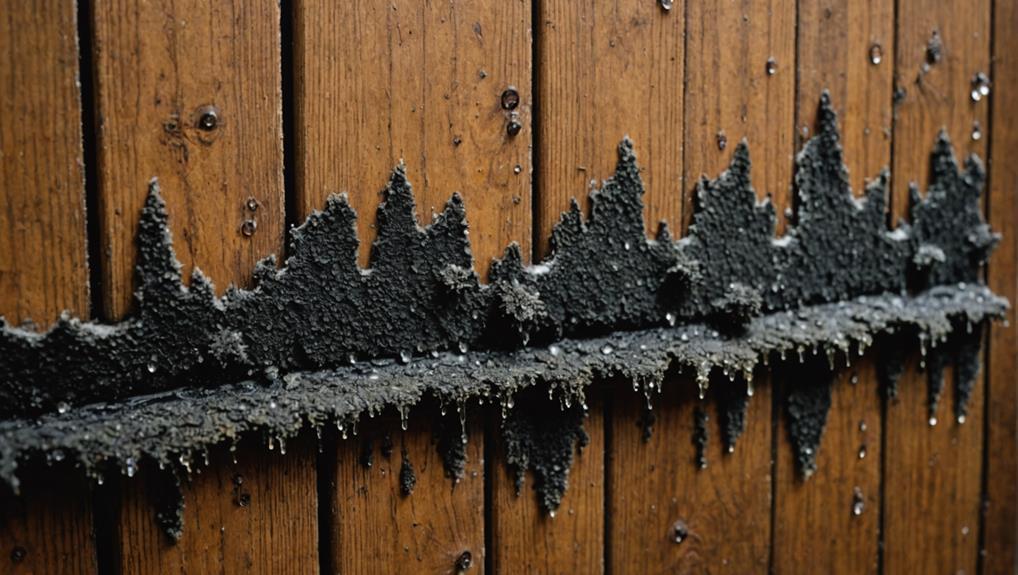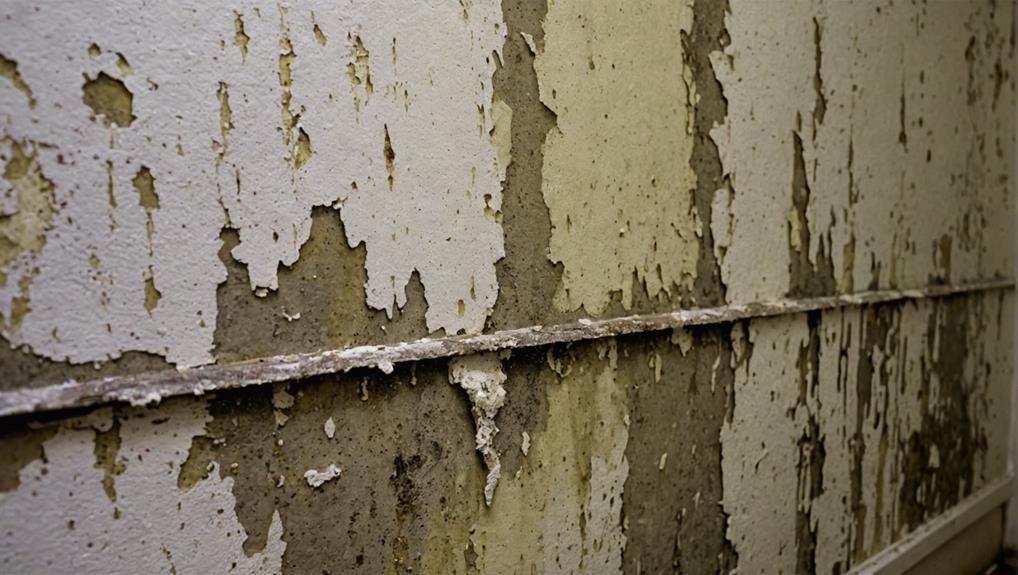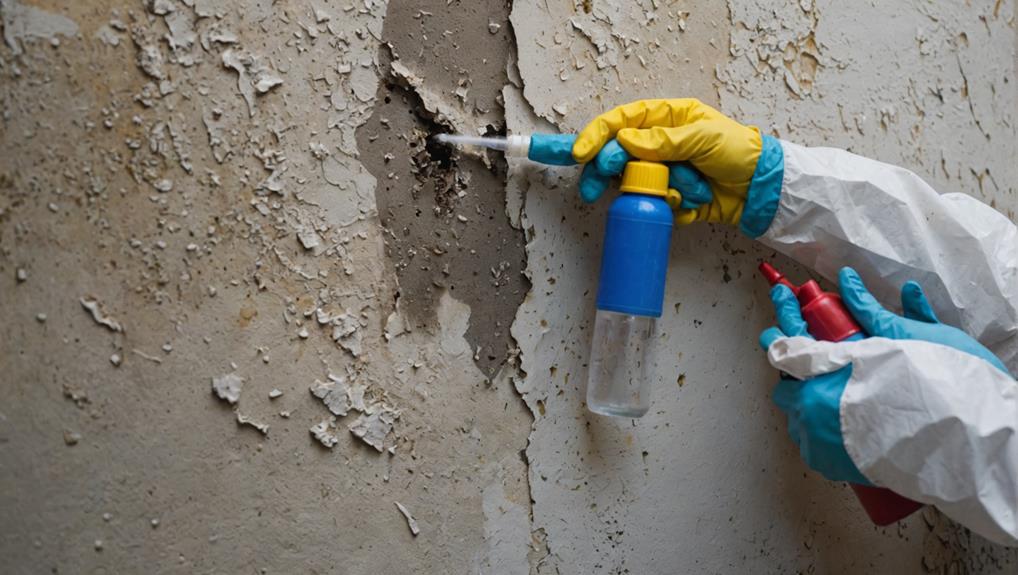Mold can silently infiltrate your walls, creating hidden dangers that directly impact your health. It thrives in damp, warm conditions, often going unnoticed until significant damage occurs. Exposure can trigger allergies, respiratory issues, and even worsen conditions like asthma. You'll want to look for signs like dark spots, musty odors, or water damage. Effective ventilation and regular inspections are key to prevention, alongside quick remediation actions if mold is detected. Staying vigilant is vital for maintaining a healthy home environment. Exploring further can reveal strategies to combat mold effectively and safeguard your living space.
Understanding Mold Growth

Although mold is a natural part of the environment, it can pose serious health risks when it grows unchecked inside your walls. To effectively manage mold, you must understand its lifecycle and the environmental factors that contribute to its growth.
Mold reproduction begins with spores, which are microscopic and can lie dormant for extended periods. When conditions become favorable—typically high humidity, warmth, and organic materials—these spores germinate, leading to visible mold growth. The mold lifecycle progresses through various stages: germination, growth, and reproduction. During the growth phase, mold can spread rapidly, often going unnoticed until significant damage has occurred.
Environmental factors play an essential role in mold development. Moisture is the primary driver; therefore, leaks, condensation, or high humidity must be addressed promptly. Furthermore, poor ventilation and inadequate insulation can create ideal breeding grounds for mold. By controlling these factors, you can disrupt the mold lifecycle before it escalates into a larger issue. Recognizing the conditions that encourage mold growth empowers you to take preventive measures, safeguarding your living environment and maintaining control over your property.
Health Risks of Mold
Mold can considerably impact your health, especially when it proliferates in enclosed spaces like walls. You may not realize it, but mold is a significant threat that can trigger a range of mold allergies and respiratory issues. When exposed to mold, your immune response can become compromised, leading to heightened sensitivity and chronic health problems.
The toxic exposure to mold can result in severe long-term effects, including persistent respiratory conditions such as asthma or bronchitis. Even though you're not allergic, inhaling mold spores can irritate your airways, causing coughing and wheezing. Skin irritation is another common consequence, manifesting as rashes or other dermatological reactions that can be both uncomfortable and distressing.
Moreover, those with weakened immune systems are particularly vulnerable to mold's adverse effects. The risk of developing infections or exacerbating existing conditions increases substantially in these individuals. Understanding these health risks is essential; you have the power to safeguard your environment. Being vigilant about mold growth in your walls can be the key to maintaining your health and well-being. Don't underestimate the hidden dangers that mold can pose.
Signs of Mold Infestation

Identifying the signs of mold infestation is crucial for maintaining a healthy living environment. Mold types can vary in appearance and can often be mistaken for dirt or stains. It's important to recognize the specific indicators that signal potential growth.
Here's a breakdown of common signs to watch for:
| Sign | Description |
|---|---|
| Visible Mold | Dark spots or patches on walls, ceilings, or floors. |
| Musty Odor | A persistent, damp smell often indicates hidden mold. |
| Water Damage | Stains, warping, or bubbling in paint or drywall. |
| Allergic Reactions | Increased sneezing, coughing, or skin irritation. |
Moisture sources play a significant role in mold proliferation. Leaking pipes, high humidity, or poor ventilation can all contribute to an enabling environment for mold. By being vigilant and proactive in identifying these signs, you empower yourself to take decisive action against mold infestations, ensuring the health and safety of your living space. Don't underestimate the potential impact of unchecked mold; awareness is your first line of defense.
Prevention Strategies
To effectively prevent mold growth, it's essential to adopt a proactive approach in your home. Start by implementing effective ventilation techniques. Make sure that areas prone to moisture, such as bathrooms and kitchens, are equipped with exhaust fans. These reduce humidity and promote air circulation, important for moisture control.
Next, regularly inspect your plumbing and appliances for leaks. Addressing even minor leaks promptly can greatly diminish the opportunity for mold to establish itself. Furthermore, consider using a dehumidifier in areas with high humidity; this appliance actively controls moisture levels, creating an inhospitable environment for mold spores.
It's also imperative to maintain your gutters and guarantee proper drainage around your home. Standing water is a breeding ground for mold, so direct water away from your foundation. When it comes to building materials, opt for mold-resistant options in high-risk areas.
Remediation Methods

When dealing with mold issues, understanding effective remediation methods is vital for restoring your home to a safe environment. You've got two primary approaches: chemical treatments and DIY solutions. Each method has its own merits and is applicable depending on the severity of the infestation.
Chemical treatments involve specialized fungicides designed to eliminate mold spores at the source. These products are potent and can penetrate porous materials, guaranteeing a thorough cleanse. Nonetheless, you must use them with caution, as they can pose health risks if misapplied. Always follow safety guidelines and consider hiring professionals for extensive infestations.
On the other hand, DIY solutions offer a more hands-on approach for minor mold problems. Common ingredients like vinegar, baking soda, and hydrogen peroxide can effectively kill mold without harsh chemicals. For a successful DIY remediation, verify proper ventilation during the process and wear protective gear to shield yourself from exposure.
Ultimately, whether you choose chemical treatments or adopt DIY solutions, the key is to act swiftly and decisively. Addressing mold promptly not only protects your home but equally empowers you to maintain a healthier living environment.
Conclusion
In the shadows of your walls, mold can silently weave a tapestry of health hazards. Recognizing its signs is vital to safeguarding your home and well-being. By implementing effective prevention strategies and knowing how to remediate any infestation, you can reclaim your space from this hidden menace. Don't let mold thrive in the dark corners of your life; take proactive steps to guarantee your sanctuary remains a healthy haven, free from its insidious grasp.
